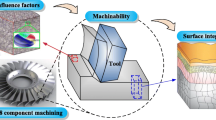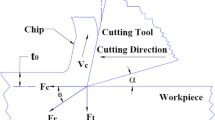Abstract
High-speed machining (HSM) is an advanced machining technology to form components. However, the poor surface integrity tends to appear due to chip flow instability in HSM. It is found that the surface integrity results from the competition of shear deformation instability between in primary shear zone (PSZ) and in separating shear zone (SSZ). To improve the surface integrity of machined components, the systematic high-speed extrusion machining (HSEM) experiments of magnesium alloy AZ31B with different constraint extrusion factors (CEFs) were carried out. The instability of shear deformation in PSZ is suppressed, and the microwaves on machined surface disappear when CEF is equal to or larger than a certain value. The measurements of the machined surface show that an improvement of surface integrity is achieved if CEF exceeds a certain value. The theoretical model for HSEM was established to elucidate the critical CEF. The underlying physics of surface integrity in HSEM is further revealed. The experimental results verify the validity of the theoretical model.
Similar content being viewed by others
References
Subbiah S (2015) Science of machining. In: Nee AYC (ed) Handbook of manufacturing engineering and technology. Springer, London, pp. 787–810. doi:10.1007/978-1-4471-4670-4_1
Fang N, Pai PS, Edwards N (2013) A comparative study of high-speed machining of Ti-6Al-4V and Inconel 718—part II: effect of dynamic tool edge wear on cutting vibrations. Int J Adv Manuf Technol 68(5–8):1417–1428
Fang N, Pai PS, Edwards N (2013) A comparative study of high-speed machining of Ti–6Al–4V and Inconel 718—part I: effect of dynamic tool edge wear on cutting forces. Int J Adv Manuf Technol 68(5–8):1839–1849
Hamdan A, Sarhan AD, Hamdi M (2012) An optimization method of the machining parameters in high-speed machining of stainless steel using coated carbide tool for best surface finish. Int J Adv Manuf Technol 58(1–4):81–91
Gu L, Wang M, Chen H, Kang G (2015) Experimental study on the process of adiabatic shear fracture in isolated segment formation in high-speed machining of hardened steel. Int J Adv Manuf Technol 1–9
Pu CL, Zhu G, Yang S, Yue EB, Subramanian SV (2015) Effect of microstructure softening events on the chip morphology of AISI 1045 steel during high speed machining. Int J Adv Manuf Technol 1–7
Singh KK, Kartik V, Singh R (2015) Modeling dynamic stability in high-speed micromilling of Ti–6Al–4V via velocity and chip load dependent cutting coefficients. Int J Mach Tools Manuf 96:56–66
Zębala W, Kowalczyk R (2014) Estimating the effect of cutting data on surface roughness and cutting force during WC-Co turning with PCD tool using Taguchi design and ANOVA analysis. Int J Adv Manuf Technol 77(9–12):2241–2256
Azeem A, Feng HY (2012) Cutting force prediction for ball-end mills with non-horizontal and rotational cutting motions. Int J Adv Manuf Technol 67(5–8):1833–1845
Tunç L, Ozkirimli OM, Budak E (2015) Machining strategy development and parameter selection in 5-axis milling based on process simulations. Int J Adv Manuf Technol 1–18
Hashmi K, Zakria G, Raza M, Khalil S (2015) Optimization of process parameters for high speed machining of Ti-6Al-4V using response surface methodology. Int J Adv Manuf Technol 1–10
Jin D, Liu Z (2012) Effect of cutting speed on surface integrity and chip morphology in high-speed machining of PM nickel-based superalloy FGH95. Int J Adv Manuf Technol 60(9–12):893–899
Thakur D, Ramamoorthy B, Vijayaraghavan L (2012) Effect of cutting parameters on the degree of work hardening and tool life during high-speed machining of Inconel 718. Int J Adv Manuf Technol 59(5–8):483–489
Sugihara T, Takemura S, Enomoto T (2015) Study on high-speed machining of Inconel 718 focusing on tool surface topography of CBN cutting tool. Int J Adv Manuf Technol 1–9
Molinari A, Soldani X, Miguélez MH (2013) Adiabatic shear banding and scaling laws in chip formation with application to cutting of Ti–6Al–4V. Journal of the Mechanics and Physics of Solids. 61(11):2331–2359
Cheng K, Huo D (2009) Basic concepts and theory. In: Cheng K (ed) Machining dynamics, Springer Series in Advanced Manufacturing. Springer, London, pp. 7–20. doi:10.1007/978-1-84628-368-0_2
Recht RF (1964) Catastrophic thermoplastic shear. J Appl Mech 31(2):189–193
von-Turkovich BF, Durham DR (1982) Machining titanium and its alloys. In: Advanced Processing Methods for Titanium, Metallurgical Society of AIME Conference, pp 257–274
Komanduri R, Hou ZB (2002) On thermoplastic shear instability in the machining of a titanium alloy (Ti-6Al-4V). Metall Mater Trans A-Phys Metall Mater Sci 33(9):2995–3010
Semiatin SL, Rao SB (1983) Shear localization during metal cutting. Mater Sci Eng 61(2):185–192
Xie JQ, Bayoumi AE, Zbib HM (1996) A study on shear banding in chip formation of orthogonal machining. Int J Mach Tools Manuf 36(7):835–847
Burns TJ, Davies MA (1997) Nonlinear dynamics model for chip segmentation in machining. Phys Rev Lett 79(3):447–450
Huang J, Kalaitzidou K, Sutherland JW, Aifantis EC (2007) Validation of a predictive model for adiabatic shear band formation in chips produced via orthogonal machining. J Mech Behav Mater 18(4):243–263
Ma W, Li X, Dai L, Ling Z (2012) Instability criterion of materials in combined stress states and its application to orthogonal cutting process. Int J Plast 30–31:18–40
Ye GG, Chen Y, Xue SF, Dai LH (2014) Critical cutting speed for onset of serrated chip flow in high speed machining. Int J Mach Tools Manuf 86:18–33
De Chiffre L (1976) Extrusion cutting. Int J Mach Tool Des Res 16(2):137–144
Brown TL, Saldana C, Murthy TG, Mann JB, Guo Y, Allard LF, King AH, Compton WD, Trumble KP, Chandrasekar S (2009) A study of the interactive effects of strain, strain rate and temperature in LSEM of copper. Acta Mater 57(18):5491–5500
Cai SL, Chen Y, Ye GG, Jiang MQ, Wang HY, Dai LH (2015) Characterization of the deformation field in large-strain extrusion machining. J Mater Process Technol 216:48–58
Cai SL, Dai LH (2014) Suppression of repeated adiabatic shear banding by dynamic large strain extrusion machining. J Mech Phys Solids 73:84–102
Liu Y, Cai SL, Dai LH (2016) A new method for grain refinement in magnesium alloy: high speed extrusion machining. Mater Sci Eng A 651:878–885
Mabrouki T, Girardin F, Asad M, Rigal JF (2008) Numerical and experimental study of dry cutting for an aeronautic aluminium alloy (A2024-T351). Int J Mach Tools Manuf 48(11):1187–1197
Thakur A, Gangopadhyay S (2016) State-of-the-art in surface integrity in machining of nickel-based super alloys. Int J Mach Tools Manuf 100:25–54
Bai YL (1982) Thermo-plastic instability in simple shear. J Mech Phys Solids 30(4):195–207
Yen YC, Jain A, Altan T (2004) A finite element analysis of orthogonal machining using different tool edge geometries. J Mater Process Technol 146(1):72–81
Efe M, Moscoso W, Trumble KP, Dale Compton W, Chandrasekar S (2012) Mechanics of LSEM and application to deformation processing of magnesium alloys. Acta Mater 60(5):2031–2042
Lee WB, Zhou M (1993) A theoretical analysis of the effect of crystallographic orientation on chip formation in micromachining. Int J Mach Tools Manuf 33(3):439–447
Johnson GR, Cook WH (1983) A constitutive model and data for metals subjected to large strains, high strain rates and high temperatures. Proceedings of 7th International Symposium on Ballistics, Am Def Prep Ass (ADPA), Netherlands, pp 12–21
Feng F, Huang S, Meng Z, Hu J, Lei Y, Zhou M, Yang Z (2014) A constitutive and fracture model for AZ31B magnesium alloy in the tensile state. Mater Sci Eng A 594:334–343
Reiner M (1964) The Deborah number. Phys Today 17(1):62–62
Dai LH, Yan M, Liu LF, Bai YL (2005) Adiabatic shear banding instability in bulk metallic glasses. Appl Phys Lett 87(14)
Liu LF, Dai LH, Bai YL, Wei BC (2005) Initiation and propagation of shear bands in Zr-based bulk metallic glass under quasi-static and dynamic shear loadings. J Non-Cryst Solids 351(40–42):3259–3270
Su G, Liu Z, Li L, Wang B (2015) Influences of chip serration on micro-topography of machined surface in high-speed cutting. Int J Mach Tools Manuf 89:202–207
Author information
Authors and Affiliations
Corresponding authors
Rights and permissions
About this article
Cite this article
Liu, Y., Cai, S., Shang, X. et al. Enhancing surface integrity by high-speed extrusion machining. Int J Adv Manuf Technol 89, 2141–2150 (2017). https://doi.org/10.1007/s00170-016-9252-6
Received:
Accepted:
Published:
Issue Date:
DOI: https://doi.org/10.1007/s00170-016-9252-6




